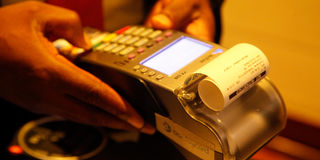Prime
Central bank reports massive growth in cashless payments

All digital payment channels, among them debit and credit cards, points-of-sale, internet and mobile banking and Mobile money, according to Bank of Uganda, increased during the year ended March.
What you need to know:
- All digital payment channels, among them debit and credit cards, points-of-sale, internet and mobile banking and Mobile money, according to Bank of Uganda, increased during the year ended March.
Cashless payments registered accelerated growth in the period ended March 2022, according to the Bank of Uganda June 2022 Financial Stability Assessment Report.
The growth, according to the report, was largely due to massive increase in volumes and values of internet and mobile banking and mobile money.
For instance, during the year ended March, the report indicates, the value of internet and mobile banking rose by 82.8 percent and 146.1 percent, respectively, while mobile money rose by 46.5 percent to Shs145.6 trillion.
The report also indicates that all electronic payment systems registered growth in both volume and value, save for credit cards and points-of-sale, which registered a 12.38 percent drop in active users and 1.05 percent drop in value, respectively .
Speaking during the Financial Stability Symposium, Mr Robert Mbabazize, the Bank of Uganda director financial stability, said the report, which seeks to foster price stability and a sound financial system, had found that there was an increase in demand for digital payments, driven by a favorable regulatory regime, evolving consumer behaviour, accelerated by Covids-19 restrictions, and recovery in economic activity.
However, he noted, cyber threats remain an inherent risk for digital channels, revealing that two banks had been affected by cyber fraud in the period.
Mr Mbabazize did not reveal which banks were affected, but indicated that Bank of Uganda is engaging financial institutions and payment system providers to implement robust cybersecurity risk management frameworks.
Last year Bank of Uganda started implementing the National Payment Systems Act, which effectively regulates electronic and digital payments that include mobile money, whose regulation was shifted from Uganda Communications Commission to the Central Bank.
The Central Bank has since May last year, when it issued its first licence to MTN Mobile Money Uganda as a payment system operator and payment service provider under the National Payment Systems Act, licensed more than 15 companies to conduct different forms of digital payments.
The licencing has accelerated the drive towards a cashless economy, which in 2019, Bank of Uganda had indicated, would largely be achieved before the end of this year.
However, the Central Bank subsequently noted that attaining a cashless economy would delay due to the absence of a number of support infrastructure to drive it.
Data from the Central Bank, however, indicates a steady growth even as cash payments continue to dominate across the country.
During the year ended March, according to data from Bank of Uganda, debit card payments increased by 23.88 percent from Shs961.9b to Shs1.1 trillion while payments through credit cards rose from Shs34.1b in March 2021 to Shs59.7b, which represents a 74.89 percent growth.
Internet banking, which registered a 17.51 percent increase from 848,691 active users in March 2021 to 997,287, registered an 82.8 percent growth in value, rising to Shs63.9 trillion from Shs34.9 trillion while the value of mobile increased by 146.09 percent from Shs2.11 trillion in March 2021 to Shs5.2 trillion in March 2021.
Mobile money, which has been one of the most effective drivers of cashless payments, grew by 46.5 percent in value from Shs101.5 trillion in March 2021 to Shs145.6 trillion.
Bank of Uganda also noted that the value of points-of-sale had during the period declined by 1.05 percent, falling from Shs719.15b in March 2021 to Shs711.58b.




